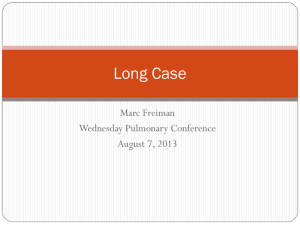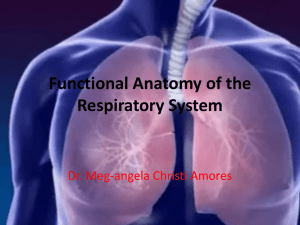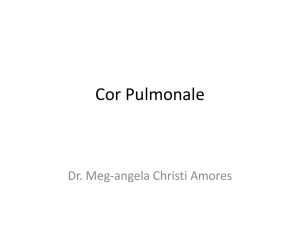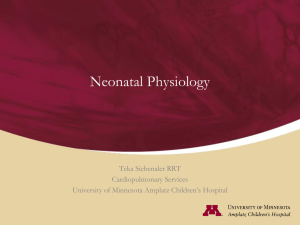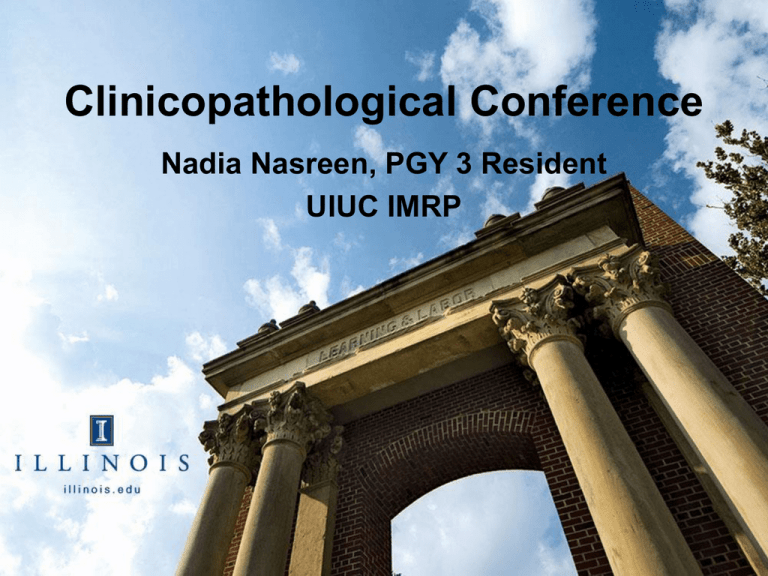
Clinicopathological Conference
Nadia Nasreen, PGY 3 Resident
UIUC IMRP
Chief Complaint
•
•
•
Chest pressure for one month progressively worsened for 2 days
Weakness for 4 days
Non-productive cough for 1 week
History of Presenting Illness
•
A 64y old Caucasian female with past medical history of hypertension and
CAD went to outside hospital with chest pressure which has been going on
for one month with worsening for 2 days. Pain was in middle of the chest,
retrosternal, 4/10, no radiation or shift, no aggravating or relieving factors,
associated with non-productive cough for last 1 week.
•
Negative for hemoptysis and weight loss.
Past Medical and Surgical History
•
•
Hyperlipidemia, CAD, Hypertension
Appendectomy, Tonsillectomy, Nasal surgery
Medications
•
ASA, Atenolol, Allegra
• Social History
•
•
•
12 pack years, quit at 28yrs of age
Worked as spray painter in a boat manufacturing industry
No alcohol or drug use
•
•
FAMILY HX:
No hx of diabetes mellitus, pre-mature heart disease or cancers .
Physical Exam
•
•
•
•
•
•
•
•
•
•
Temp: 97.9 F, Pulse : 81/min, Resp: 18/min , BP: 118/69, SpO2 : 99% on 2L
GEN: AO x 3, no distress
HEENT : Non-contributory
NECK: No JVD, No lymph-adenopathy
Chest: Non tender on palpation, clear on auscultation B/L
Heart : Normal heart sounds, No murmurs heard
Abdomen: Soft, non-tender, no organomegaly,BS+
Extremities: No edema, DP +
Neuro: Non-focal exam
Skin: No rashes , echymosis or purpura
Labs
Na
134
K
4
Cl
100
HCO3
24
BUN
9
Creatinine
0.7
Glucose
171
Ca
8.9
Total Bili
0.4
AST
20
ALT
17
Alk Phos
86
Total protein
8
ALB
4.6
Labs
WBC
10.8
Hgb
11.9
Hct
35.3
MCV
87.2
MCH
29.5
MCHC
33.8
RDW
14.9
Plt Count
188
Neut %
84.5
LYMPH %
9.9
Mono %
5.6
Eos %
0
Baso %
0
PT
10.6
INR
1
PTT
24.6
Summary
•
64 y/o caucasian female with PMH of HTN, CAD, presented with 1 month
H/O retrosternal, non radiating 4/10, chest pressure, progressively
worsening for last 2 days, weakness for 4 days, nonproductive cough for 1
week with no hemoptysis or weight loss. Remote H/O smoking , quit 36
years back and worked as a boat painter.
•
Lab- significant only for Mild normocytic anemia.
Additional History Required
• Comprehensive review of systems- Fever or chill, night sweat,
anorexia.
• Any Associated SOB, dysphagia, odynophagia , hoarseness
• Pain with deep breathing or coughing
• Description of weakness- Focal or generalized, vs any UE s/snumbness/paresthesia
• Axillary, inguinal supraclavicular lymph node examination
• Any Breast examination for lump/mass
• Lateral CXR to evaluate the mediastinal location.
Imaging
Lung vs Mediastinal Mass
•
•
The following characteristics indicate that a lesion originates within the
mediastinum:
Mediastinal mass will not contain air bronchograms.
•
Mediastinal lines (azygoesophageal recess, anterior and posterior junction
lines) will be disrupted.
•
There can be associated spinal, costal or sternal abnormalities.
•
A lung mass abutts the mediastinal surface and creates acute angles with
the lung, while a mediastinal mass will sit under the surface creating
obtuse angles with the lung
Anterior Mediastinum
Middle Mediastinum
Posterior mediastinum
Structures
included
Upper esophagus, trachea,
thymus, aortic arch, and
lymphatic vessels.
pericardium/heart, distal trachea,
main bronchi, and lymph nodes
esophagus, descending
aorta, sympathetic ganglia,
and peripheral nerves.
Most
common
lesions/Mas
ses
5Ts
Thymoma/T carcinoma
Thyroid or parathyroid
tumors
Hodgkins disease orTcell
Lymphoma
Teratoma( or G cell
tumors)
Esophageal lesions:
include leiomyomas,
fibromas
lipomas, Carcinoma
Metastatic LAD
lymphoma,
granulomatous disease
(sarcoidosis, fungal infections,
pulmonary TB), Giant lymph
node hyperplasia (Castleman
disease
pericardial or bronchogenic
cysts, vascular masses and
enlargements, and
diaphragmatic hernias.
Neural tumors include
neurofibroma and
neurilemmoma
(schwannoma).
Duplication cyst
Hiatus hernia
>1
compartmen
t
Infections, Hemorrhage
Lung cancers
Hemangioma, lymphangioma
Mediastinitis
Imaging
Imaging
Differential Diagnoses
Bronchogenic Carcinoma
Primary Lung cancer
NSCLC vs SCLC
Metastatic neoplasms to Lungs
Sarcomatoid carcinoma
Lymphoproliferative disorders
NHL
Hodgkins lymphoma
Primary mediastinal large B cell
Lymphoma
Primary Pulmonary Lymphoma
Extramedullary plasmacytoma
(primary pulmonary plasmacytoma)
Lymphomatoid granulomatosis
Postobstructive pneumonia
Viral or bacterial pneumonia
Atypical/ Chronic Infections Pulmonary TB
Fungal –
Histoplasmosis
Aspergillosis,
Blastomycosis
Cryptococcal
coccidioidimycosis
Bronchial Carcinoid
Sarcoidosis
Collagen vascular disease- GPA(
Wegners), SLE, RA
Asbestos associated Lung disease
Mediastinal involvement( Mainly
posterior)
Esophageal Carcinoma
Neurogenic tumors- Schwannomas,
meningocele, paraspinal
Ganglioneuroma
Bronchogenic Carcinoma
•
Lung cancer is the leading cause of cancer death in the United States,
accounting for approximately 29% of all cancer deaths.
•
lung cancer is the second most common cancer in man and women
•
During 2008, approximately 213,380 new cases of lung cancer were diagnosed
(114,760 among men and 98,620 among women).
Epidemiology
•
•
Age Distribution-predominately in persons aged 50-70 years.
Nearly 70% of patients are older than 65 years and fewer than 3% are younger
than 45 years.
•
Sex- In the United States, the probability of developing lung cancer remains
equal in both sexes until age 39 years It then starts to increase among men
compared with women, reaching a maximum in those older than 70 years.
•
Prevalence-incidence rates are similar among African American and white
women.
Approximately 45% higher among African American men than among white
men
Current 5-year survival rates are estimated to be 16% among whites and 13%
among non-whites
•
•
Etiology
•
•
•
•
•
Causes:
Smoking (90% of all Lung cancers)The risk of developing lung cancer for a current smoker of 1 ppd for 40 years
is approximately 20 times that of someone who has never smoked.
Risk declines slowly after smoking cessation. The relative risk remains high in
the first 10 years after cessation and gradually declines to 2-fold
approximately 30 years after cessation.
Asbestos exposure- risk of Lung cancer is 5 times. Synergistic with smoking80-90 times greater risk than control population
•
•
•
Environmental toxins
- Radon , halogen , ether, arsenic atmospheric pollution
Chromium, nickel , Vinyl chloride
•
Radiation therapy —increase the risk of a second primary lung cancer in
patients who have been treated for other malignancies.
•
Pulmonary fibrosis —The risk for lung cancer is increased about sevenfold
patients with pulmonary fibrosis, Independent of Smoking
•
HIV infection — The incidence among individuals infected with HIV appears to be
increased compared to that seen in uninfected controls
•
Genetic Exposure-. The ras gene mutations occur almost exclusively in
adenocarcinoma and are found in 30% of such cases.
mutations in c-myc and c-raf among oncogenes and retinoblastoma (Rb) and p53
among tumor suppressor gene are found in NSCLC include
•
Classification
Lung Cancer
Non-small Cell Cancer- 85%90% of Lung cancers
Adenocarcinoma((including bronchioloalveolar carcinoma)
— 38 percent
Squamous cell carcinoma
— 20 percent
Large Cell Carcinoma
- 5%
Other non-small cell carcinomas
cannot be further classified
(18 percent)
Others- Sarcomatoid, NE tumors6%
Small Cell Lung cancer- 10%15%of Lung cancers
Adenocarcinoma
•
Adenocarcinoma, arising from the bronchial mucosal glands
•
•
•
The most frequent NSCLC in the United States, -35-40% of all lung cancers.
It usually occurs in a peripheral location within the lung.
Adenocarcinoma is the most common histologic subtype, and may manifest as a
“scar carcinoma.” most commonly in persons who do not smoke. This type
may manifest as multifocal tumors in a bronchoalveolar form.
Significant variation in architecture of neoplastic gland formation.
•
•
Variant Subtypes:
- Acinar
- Papillary
- Bronchiloalveolar Carcinoma
- Solid Adenocarcinoma with mucin production
Bronchiloalveolar Carcinoma
•
•
•
•
Bronchoalveolar carcinoma is a distinct subtype of adenocarcinoma with a
classic manifestation as an interstitial lung disease on chest
radiograph.
Bronchoalveolar carcinoma arises from type II pneumocytes and grows
along alveolar septa. This subtype may manifest as a solitary peripheral
nodule, multifocal disease, or a rapidly progressing pneumonic form.
A characteristic finding in persons with advanced disease is voluminous
watery sputum.
In the new classification scheme, these tumors have been renamed as
adenocarcinoma in situ
has a propensity for intrapulmonary metastases and a more indolent
course
Squamous Cell Carcinoma
•
•
25-30% of all lung cancers.
Tends to occur centrally, with endobronchial lesions
•
Histologically : presence of keratin pearls detected with cytologic studies and
has a tendency to exfoliate. It is the type most often associated with
hypercalcemia.
Historically, most squamous cell carcinoma (60 to 80 percent) arose in the
proximal portions of the tracheobronchial tree
•
•
•
A minority of cases occur peripherally and may be associated with
bronchiectatic cavities or scars. Central and peripheral squamous cell
carcinomas may show extensive central necrosis with resulting
cavitation
The classic manifestation is a cavitary lesion in a proximal bronchus.
Large Cell Undifferentiated Carcinoma
•
•
only 10% of lung cancers.
Typically manifest as a large peripheral mass on chest radiograph
•
Histologically, this type has sheets of highly atypical cells with focal
necrosis, with no evidence of keratinization (typical of SCC) or gland
formation (typical of adenocarcinomas).
•
LCC is a diagnosis of exclusion intended to include all poorly
differentiated NSCLCs that are not further classifiable by routine light
microscopy.
Sarcomatoid Carcinoma
•
Represents a heterogeneous group of NSCLCs that contain a component of
sarcoma or sarcoma-like elements:
Pleomorphic carcinoma
Spindle cell carcinoma
Giant cell carcinoma
Carcinosarcoma —defined by the presence of a typical carcinoma
combined with sarcomatous elements (bone, cartilage or skeletal muscle).
Typical sarcomatous components include rhabdomyosarcoma,
osteosarcoma, and chondrosarcoma.
Pulmonary blastoma —biphasic malignancies that have an adenocarcinoma
component that has the appearance of fetal adenocarcinoma and a stroma
that resembles that seen in Wilms tumor. They are usually large at the time
of presentation and are highly malignant
Pulmonary Neuroendocrine Tumors
•
•
•
•
Small cell carcinoma
large cell neuroendocrine carcinoma
Typical carcinoid, and atypical carcinoid
DIPNH- diffuse idiopathic pulmonary neuroendocrine cell hyperplasia, a
possibly preinvasive epithelial lesion
•
Typical and atypical carcinoids - similar to carcinoid lesions arising at
other sites.
Small cell carcinomas and large cell neuroendocrine carcinomas more
aggressive course and pathologically by a much higher mitotic activities.
•
Small Cell Lung Cancer
Small cell lung carcinoma (SCLC) accounts for approximately 15 percent of
all bronchogenic carcinomas.
SCLC shows a strong correlation(>95%) with cigarette smoking and is
extremely rare in persons who have never smoked.
SCLC is usually more aggressive than NSCLC .
Presents as a central lesion with hilar and mediastinal invasion along
with regional adenopathy.
65-70% of patients with SCLC have disseminated or extensive disease at
presentation
The most common sites of metastasis of lung cancer are the bones, liver,
adrenal glands, pericardium, brain, and spinal cord.
production of various peptide hormones leads to a wide range of
paraneoplastic syndromes
Clinical presentations
•
•
•
•
Paraneoplastic Syndromes from lung cancers:
Hypercalcemia- Squamous cell carcinoma
Trousseau syndrome- Adenocarcinoma
Hypertrophic pulmonary osteoarthropathyNSCLC
• Clubbing – all types.
Paraneoplastic Syndromes Of SCLC
Organ System
•
Endocrine
Syndrome
Mechanism
Frequency
SIADH
Antidiuretic
homone
5%- 10%
Ectopic sec of ACTH
ACTH
5%
Atrial Natriuretic factors
Eaton-Lambert reverse
myasthenic syndrome
Neurologic
5%-6%
Subacute cerebellar
degeneration
Subacute sensory
neuropathy
Limbic encephalopathy
Anti-Hu, Anti-Yo
antibodies
Diagnostic Imaging
•
•
•
•
•
•
•
•
•
•
CXR- may show the following:
Pulmonary nodule, mass, or infiltrate
Mediastinal widening
Atelectasis
Hilar enlargement
Pleural effusion
CT Scan -mediastinal lymphadenopathy. CT had a pooled sensitivity of 57%,
a specificity of 82%, and a negative predictive value of 83%.
PET FDG- pooled sensitivity of 84% and a specificity of 89%, with a PPV of
79% and a NPV of 93%.
Combined positive predictive value and negative predictive value of CT
scanning and PET-FDG were 83% to 93% and 88% to 95%, respectively.
PET-FDG is superior to CT scanning in the staging of disease in patients
with mediastinal lymph node involvement.
Staging of SCLC
•
•
TNM system is generally not used in these patients.
The Veterans Administration Lung Study Group staging system is typically used, :
as limited or extensive.
•
Limited-stage disease -limited to one hemithorax, with hilar and mediastinal
lymphadenopathy that can be encompassed within one tolerable radiotherapy
portal.
•
Extensive-stage disease consists of any disease that exceeds those boundaries.
Most patients (60% to 70%) with SCLC present with clinically extensive-stage
disease. significant differences in median and 5-year survival among these patients
depending on the stages.
Combination chemotherapy is the cornerstone of treatment for both limitedstage and extensive-stage SCLC.
Metastatic Neoplasm to Lungs
•
•
•
•
•
•
•
•
•
•
Approximately 10-30% of all malignant nodules resected from the lung are
metastatic
Frequent sources of malignancy:
Head and neck
Colon
Kidney
Breast
Thyroid gland
Melanoma
In addition to solitary or multiple nodules, metastases of carcinoma to the
lung include lymphangiitic, endobronchial, pleural, and embolic
patterns.
Most common Clinical situation: multiple or innumerable nodules.
Lymphomatous proliferation involving
Lungs
3 different ways:
Haematogenous dissemination of Non-Hodgkins lymphoma (NHL) or
Hodgkins disease
Contiguous invasion from a hilar or mediastinal site of nodal lymphoma
Primary pulmonary involvement.
Non-Hodgkins Lymphoma
•
•
•
•
Epidemiology- Approximately 56,000 new cases (NHL) are diagnosed in the
United States annually, with approximately 24,000 people dying from this disease
each year.
The incidence of NHL increases exponentially with age and is greater in men
than women and in whites than blacks.
Risk Factors:
• Autoimmune disease and immunodeficiency states have a known
association with NHL.
• NHL may also be caused by viruses – EBV- Burkitts lymphoma, HTLV1- Adult T cell leukemia- lymphoma, HHV-8- Body cavity lymphoma
• Several chemicals, such as organochlorine agents (for example,
DDT), have been weakly associated with an increased risk for NHL.
• Farming - consistently shows an association with an increased risk for
NHL, which is often thought to be related to the use of pesticides
• WHO Classification Of Lymphoid Malignancy
Lymphoid
Neoplasms
B cell neoplasms
T- cell and NK -cell
neoplasms
Classification Criteria:
Morphology
Clinical features
Genetic features
Immunophenotype
Hodgkins
Lymphoma
•
•
•
80%-85% of NHL in adults are B-cell in origin
Remainder – mostly T cell in origin
B cell Lymphomas- based on biology and natural history:
Indolent vs Aggressive vs Highly aggressive Groups
Indolent
Aggressive
Highly Aggressive
Small Lymphocytic
Diffuse large cell
Burkett
Follicular
Mantle Cell
Lymphoblastic
Marginal
MALT
Splenic
Nodal
AIDS related
Clinical presentations
•
-
-
•
•
Aggressive NHLs acutely or subacutely with a rapidly growing mass, systemic B symptoms (ie,
fever, night sweats, weight loss), and/or elevated levels of serum LDH and uric
acid
50% present with secondary extranodal disease, 10%-35% Primary extranodal
lymphoma
- Most common EN site- GI tract then skin. Others – Testis, Bone, Kidney
potentially are curable with combination chemotherapy.
Indolent lymphomas
Are often insidious, presenting only with slow growing lymphadenopathy,
hepatomegaly, splenomegaly, or cytopenias..
Mostly present at advanced stage, incurable
Median survival 7-10years.
Chest and Lung NHL
•
•
•
•
•
•
Approximately 20 percent of patients with NHL present with mediastinal
adenopathy on clinical examination or chest radiograph
Primary mediastinal large B cell lymphoma or part of diffuse Systemic
disease
Cough, chest discomfort, or asymptomatic with abnormal CXR
3%-8%- SVC syndrome
Other - include pleural and, less commonly, pericardial effusions.
Chylothorax, alone or in combination with chylopericardium or chylous
ascites
Pleural disease is seen in up to 10 percent of all patients with NHL at
diagnosis.
PA (upper panel) and lateral (lower panel) radiographs of a patient with a large
right-sided mediastinal mass (arrows). The biopsy was consistent with diffuse large
B-cell non-Hodgkin's lymphoma.
CT scan of Chest in NHL
- Typical radiographic findings include alveolar opacities (consolidation,
masses, or nodules) and peribronchial disease.
- parenchymal lung lesions can be seen with no evidence of mediastinal or
hilar lymphadenopathy.
Diagnosis:
NCCN recommends- An excisional biopsy of an intact node
- histologic, immunologic, and molecular biologic assessment
Including flow cytometry and fluorescent in-situ hybridization or cytogenetics.
Staging- CT chest abdomen, pelvis, PET scan, CBC, CMP, LDH, β −
2 microglobulin, Uric acid, BM Bx, Lumber puncture, Echocardiogram, NM scan
Diffuse Large B Cell Lymphoma
•
•
Most common Lymphoid malignancy. 25% of NHL
Caucasian Americans having higher rates than Blacks, Asians, and American
Indian or Alaska Natives
•
•
male predominance ; approximately 55 percent of cases in men
Median age at presentation is 64 years. Younger for Blacks.
•
Typically presents as rapidly enlarging symptomatic mass, nodal enlargementusually neck and abdomen
B-symptoms- 30%
BM – 30%, Extramedullary- 40%
•
•
•
tumors derived from germinal center B cells or post-germinal center B cells (also
called activated B cells)
•
majority of DLBCL tumors demonstrate translocations or mutations that result in
the increased expression of the B cell lymphoma 6 (BCL-6) gene.
PMLBL
Systemic DLBL with mediastinal
involvement
Younger women-3rd-4thdecade
Older age at Dx- median age at Dx-7th
decade
locally invasive anterior mediastinal mass with
invasion of local structures ,(SVC, effusion)
If BM involvement or more distant LN spread
then Dx is more likely DLBL
Systemic B symptoms and elevated LDH levels
are not uncommon.
Can spread to Supraclavicular and cervical LN
later to Kidneys or CNS
Immunophenotypingexpress pan-B cell antigens, have weak
expression of CD30, and only rarely express
CD15
express pan B cell antigens (CD19, CD20,
CD22, CD79a), as well as CD45
50%-75% of tumors express surface or
cytoplasmic monoclonal (Ig), most often of
the IgM isotype.
Hodgkins Lymphoma
Arises from germinal or post-germinal center B cells.
Incidence- approximately 10 percent of all lymphomas in economically advanced
countries.
Age and sex- Bimodal distribution- 1 peak in young adults (age 20 years) and one in
older age (age 65 years); the majority of patients are young adults; male
predominance
Based on the appearance and immunophenotype of the tumor cells:
Nodular lymphocyte predominant HL (NLPHL)
Classical HL
Classic HL is usually diagnosed by lymph node biopsy.
On light microscopy, the tumor contains a minority of neoplastic cells (ReedSternberg cells and their variants) in an inflammatory background.
The neoplastic cells typically express CD15 and CD30, variably express CD20, and
do not express CD3 or CD45
•
•
•
•
•
Classical HL is further divided into the following four subtypes:
Nodular sclerosis classical HL
Mixed cellularity classical HL
Lymphocyte rich classical HL
Lymphocyte depleted classical HL
•
•
•
•
•
Clinical presentations include
Nontender lymphadenopathy in the neck or mediastinum
Incidental finding of a mediastinal mass on routine chest x-ray
Systemic symptoms - in less than 20 percent of stage I/II Hodgkin lymphoma
up to 50 percent of patients with more advanced disease.
•
Nonspecific symptoms- retroperitoneal LAD, cholestatic liver disease, alcoholinduced pain, skin lesions, neurologic symptoms, nephrotic syndrome,
hypercalcemia, and abnormalities in blood counts.
Spread- via lymphatic channels before disseminating to distant nonadjacent
sites and organs.
It is uncommon to have pulmonary disease at presentation without
Hodgkin lymphoma being present within the hilar lymph nodes, usually
on the ipsilateral side
•
•
Primary Pulmonary Lymphoma (PPL)
•
•
•
•
•
•
clonal lymphoid proliferation affecting one or both lungs (parenchyma and/or
bronchi) in a patient with no detectable extrapulmonary involvement at
diagnosis or during the subsequent 3 months
PPL is very rare; 0.5–1% of primary pulmonary malignancies, <1% of
NHL
The current definition of PPL covers:
1) lowgrade B-cell PPL (PPL-B), the most frequent form
2) high-grade PPL-B
3) lymphomatoid granulomatosis (LG), a rare disorder.
Low grade B-cell PPL
Bronchial MALT lymphoma
58–87% of cases of PPL.
90% of these cases correspond to MALTtype NHL
Age of onset is- 50–60 yrs (12–79 yrs)
The two sexes are equally affected
High grade PPL-B
11-19% cases of PPL
MALT type NHL coexists in ~50% of cases
Often occurs in pts with underlying disorders
HIV, Immunosuppresive medications.
Sjogren’s.
Median age- ~60yrs
50% are asymptomatic at Dx, With Incidental
CXR
Usual CXR-50%- 90%
Localized alveolar opacity with<5 cm
diam and associated with air
bronchogram (50%)
CT- Bilateral and multiple appx 60%-70%,
can- hilar or med LAD
<10%- B/L reticulonodular opacities,
atelectasisor pleural effusion
Usually symptomatic, Resp s/s, fever or wt
loss
Radiology: Single pulmonary mass or
atelectasis. Pleural effusion
HIV- Multiple excavated opacities
Bronchial , Transbronchial or transthoracic
biopsy
BX Blast like lymphoid cell with high mitotic
activity
5 year survival rate >80%,
Median survival time >10yrs
Prognosis is poor. Median survival 8-10yrs
Lymphomatoid Granulomatosis
•
•
•
•
•
•
•
Lymphoproliferative disorder in the family of Epstein-Barr virus (EBV)associated B cell lymphomas. Extremely rare
Age of onset- 30 and 50, Men are more commonly affected than women,
with an estimated male to female ratio of 2:1.
The lung is the most commonly involved organ; the skin and neurologic
system may be affected separately or concurrently.
most common presenting symptoms and signs include cough, fever,
rash/nodules, malaise, weight loss, neurologic abnormalities, dyspnea, and
chest pain.
CXR typically shows- multiple ill-defined nodular opacities.
Histolgy- triad of polymorphic lymphoid infiltrates, transmural infiltration of
arteries and veins by lymphoid cells ("angiitis"), and focal areas of necrosis
within the lymphoid infiltrates
clinical course is variable, ranging from remission without treatment to death
within 2 years from malignant lymphoma.
Pulmonary Tuberculosis
•
•
•
Mycobacterium tuberculosis, an acid-fast–staining bacillus- inhaled into the
respiratory system by airborne droplets.
Prevalence in foreign-born U.S. residents is 9.7 times higher than that in U.S.born persons
In the AW- alveolar macrophages ingest the bacteria .Can not arrest the
multiplications- get destroyed
•
Infected macrophages are carried to LN- Form Ghon complex- (localized
parenchymal infection and lymph node involvement)- quiescent state- infection
is recognized only by reactivity to tuberculin skin testing.
•
Malnutrition, immunosuppressed states, and stress are risk factors for primary
progression or reactivation of quiescent tuberculosis.
•
In some patients, a pulmonary Ghon complex may reach significant size and
calcification status to be visible on radiographs.
•
•
•
•
•
Clinical menifestations:
pulmonary tuberculosis are often asymptomatic.
Constitutional symptoms, including anorexia, fatigue, weight loss, chills, fever,
night sweats, and local symptoms such as cough, may develop.
Hemoptysis and chest pain from pleural involvement indicate advanced disease.
HIV-infected or other immunocompromised patients - greater likelihood of
.
dissemination or extrapulmonary infection
•
•
•
•
•
Radiological findings:
Reactivation tuberculosis classically - lesions in the apical-posterior segments
of the upper lung and superior segments of the lower lobe. Cavitation may
be present.
Primary progressive tuberculosis may manifest as hilar lymphadenopathy or
infiltrates in any part of the lung, similar to bacterial pneumonia.
Atypical or absent radiologic findings commonly occur in in
immunocompromised patients.
Miliary tuberculosis may have the characteristic “millet seed” appearance. CT
scans may identify abnormalities not yet visible on chest radiographs.
Pulmonary histoplasmosis
•
•
•
•
•
Most prevalent endemic mycosis in the United States. Most prevalent in the
midwestern and central states along the Ohio and Mississippi River
valleys.
H. capsulatum proliferates best in soil contaminated with bird or bat droppings,
favoring sporulation of the organism.
Exposure include excavation, construction, demolition, remodeling, wood cutting
and gathering, and exploring caves.
Majority of cases- Lungs provide portal of entry. Cause a localized or patchy
bronchopneumonia.
Most common syndrome following infection- Asymptomatic pulmonary
histoplasmosis
• Symptomatic pulmonary histoplasmosis- typically presents as a subacute
pulmonary infection weeks to months following exposure-productive cough,
dyspnea, chest pain, fatigue, fevers, and sweats and
Radiographs typically show focal fibrotic apical infiltrates with cavitation
and mediastinal or hilar lymphadenopathy.
•
•
Following extensive exposure, - majority of patients develop acute diffuse
pulmonary histoplasmosis within a week or two.
Diffuse reticulonodular or miliary pulmonary infiltrates are noted and the
disease can progress to respiratory failure or progressive extrapulmonary
dissemination
Patients with underlying lung disease are at risk for the development of chronic
pulmonary infection following exposure .
Shared similar findings as Sarcoidosis;
Histoplasmosis must be excluded before treating patients with presumed
sarcoidosis with immunosuppressive medications
•
Positive fungal stains or cultures and detection of antigen in urine or serum support
a diagnosis of active histoplasmosis rather than sarcoidosis.
•
Elevated titers of antibodies to H. capsulatum do not exclude a diagnosis of
sarcoidosis .
Blastomycosis
Aspergillosis
Blastomyces dermatitidis is a dimorphic fungus
found primarily in the southeastern United
States; around the Great Lakes.
Aspergillus is a ubiquitous mold found in soil
and other moist environments throughout the
world
lungs are the most common site of infection,
followed by the skin, bones, and genitourinary tract.
Classically, the diseases caused by
Aspergillus species are:
Allergic bronchopulmonary aspergillosis.
Invasive aspergillosis,
Aspergilloma (fungus ball).
C/F: Asymptyomatic in 50% cases, Acute or
chronic pneumonia( Chronic more common)
Extrapulmonary symptoms
Acute PNA- resembles- viral or bacterial CAP
Chronic- cases- often mimic malignancy or TB
Low grade fever, cough with productive sputum,
chest pain, SOB, hemoptysis, with or w/o wt loss
EP features- Skin- 2nd most common- verrucous or
ulcerative lesions,SQ nodules, OM next common
Risk factors- for invasive aspergillosis
neutropenia, corticosteroid therapy, HSC
/solid organ transplantation, advanced
AIDS, and chronic granulomatous
disease.
ABPA- is manifested by as persistent severe
asthma, expectoration of brown sputum that
contains Aspergillus organisms, pulmonary
infiltrates, and fibrosis.
Aspergilloma has been divided into chronic
cavitary aspergillosis and single
aspergilloma.
Blastomycosis
Aspergillosis
Radiographic--Alveolar infiltrates with or
without cavitation, mass lesions, and
fibronodular infiltrates are most common .
Tree in bud opacities
More common in upper lobes.
Small pleural effusion or thickening
common. No hilar LAD
CT scan- The “halo sign” (nodules bordered
by a ground-glass attenuation) is the classic
finding
Dx- Culture of specimen
Direct visualization yeast form in clinical
specimens
Dx- culture from BAL, transbronchial biopsy,
needle aspiration, and VAT biopsy.
A definitive diagnosis requires histologic
demonstration of the organisms in tissue.
If not possible- Fungal Ag assay in blood,
CSF, or urine
Galactomannan assays of blood or spinal
fluid; and assays for (1-3)-β-D glucans.
Cryptococcal infections
Coccidioidimycosis
Common opportunistic pathogen, associated
mainly with HIV and, less frequently,
transplantation.
dimorphic fungus that lives in soil in parts of Arizona,
California, New Mexico, west Texas, and parts of northern
Mexico
The disease is transmitted through inhalation of the
arthroconidia, which are formed from the mycelia in soil
The lungs are the presumed portal of entry, and
pulmonary disease is one of the most common
manifestations.
(CNS) disease may also occur.
Subclinical primary infections are common and
most are asymptomatic.
Infection can persist in a latent state; if the host
immune system becomes compromised
organisms may be liberated from the
granulomatous complexes and cause active
infection.
Symptomatic pulmonary cryptococcosis
can also occur in apparently immunocompetent
patients.
C/F - range from asymptomatic pneumonia to
acute respiratory failure. The presentation of
pulmonary cryptococcosis in patients with HIV is
more acute and severe than in other hosts.
More than 50% of all infections are subclinical
- C/F- acute or subacute pneumonia, w/wo pleural
effusions or empyema
Xray- of acute disease may show infiltrates; pleural
effusions or empyema; and cavitary lesions.
Xray- in chronic infections may show findings
consistent with COPD, fibrosis, infiltrates and thin-walled
cavities.
Differential Diagnosis
Bronchogenic Carcinoma
Primary Lung cancer
NSCLC vs SCLC
Metastatic neoplasms to Lungs
Sarcomatoid carcinoma
Lymphoproliferative disorders
NHL
Hodgkins lymphoma
Primary mediastinal large B cell
Lymphoma
Primary Pulmonary Lymphoma
Extramedullary plasmacytoma
(primary pulmonary plasmacytoma)
Lymphomatoid granulomatosis
Postobstructive pneumonia
Viral or bacterial pneumonia
Atypical/ Chronic Infections Pulmonary TB
Fungal –
Histoplasmosis
Aspergillosis,
Blastomycosis
Cryptococcal
coccidioidimycosis
Bronchial Carcinoid
Sarcoidosis
Collagen vascular disease- GPA(
Wegners), SLE, RA
Asbestos associated Lung disease
Mediastinal involvement( Mainly
posterior)
Esophageal Carcinoma
Neurogenic tumors- Schwannomas,
meningocele, paraspinal
Ganglioneuroma
Bronchial Carcinoid Tumors
•
•
•
•
•
•
•
•
•
•
Low grade malignant neoplasm characterized by neuroendocrine differentiation
and indolent clinical behavior
1%-2% of all lung malignancies, 20% of all carcinoids
Lung- 2nd most common site after GI tract
Typical vs Atypical Carcinoid
Average age of onset of typical B Carcinoid-45 years
Atypical carcinoid- appears approx 10 years later
80% to 90% of tumors develop within a bronchus of subsegmental size or
greater.
10% to 20% of tumors are located in the pulmonary periphery.
Atypical carcinoid tumors comprise about 10% of all pulmonary carcinoid
tumors.
endodermal origin, arising from stem cells of the bronchial epithelium known as
Kulchitsky cells.
•
•
Secrets biologically active peptides and hormones;
serotonin, ACTH, ADH, melanocyte-stimulating hormone (MSH), and others.
•
Excess serotonin production -Carcinoid syndrome. (constellation of
symptoms, including tachycardia, flushing,bronchoconstriction,
hemodynamic instability, diarrhea, and acidosis)
Carcinoid syndrome much less frequent in pulmonary type than GI
carcinoid. <2%.
•
•
Cushing’s Syndrome: 1 to 2 percent of patients with bronchial carcinoid
tumors and can be the initial reason for seeking medical attention. The onset
is usually acute, and hypokalemia is often present.
•
•
•
•
Clinical presentation:
Most of them centrally-located tumor & are symptomatic from the tumor mass
with coughing, hemoptysis, wheezing, or a recurrent postobstructive pneumonia.
Peripheral lesions present most often as an asymptomatic solitary pulmonary
nodule.
Atypical carcinoids present more often with hilar or mediastinal nodal
metastases and have a higher recurrence rate compared with typical carcinoids.
•
Diagnosis: CT scan is the most useful imaging procedure,
•
Generally confirmed either by bronchoscopic biopsy (for central lesions) or by
transthoracic needle biopsy for peripheral lesions
Sarcoidosis
•
•
•
•
•
•
•
Multisystem, granulomatous, inflammatory condition of unknown cause that
occurs in young adults of both sexes.
3-4 times more common in African American than White. 70%-90% of the cases
occur 10-40 years of age
Ranges from asymptomatic to acute systemic presentations with fever, erythema
nodosum, polyarthralgia, and hilar lymphadenopathy (Löfgren syndrome).
90% of patients have pulmonary involvement at the time of presentation.
Typical Xray findings- B/L hilar LAD, Reticular opacities
Commonly involves the eyes and skin; the CNS, heart.GI tract are less
commonly involved.
HRCT is not required in most patients, but findings can be characteristic -a
pattern of reticulonodular abnormalities in a central distribution along the
bronchovascular lymphatic vessels associated with bilateral hilar and
mediastinal lymphadenopathy.
•
Diagnosis:
Elevated angiotensin converting enzyme (ACE) level and hypercalciuria.
Pulmonary function tests - demonstrate a restrictive defect with impaired gas
exchange.
Elevated CD4 to CD8 ratio may be detected by BAL.
Noncaseating granulomas are the characteristic histopathologic abnormality.
Classical Lofgren's syndrome and bilateral hilar LAD do not require biopsy .
The diagnosis- requires compatible clinical and radiographic manifestations,
exclusion of other diseases that may present similarly, and histopathologic
detection of noncaseating granulomas
Neurogenic tumors
•
•
•
•
•
•
•
19 to 39 percent of all mediastinal tumors
Develop from mediastinal peripheral nerves, sympathetic and
parasympathetic ganglia, and embryonic remnants of the neural tube.
most frequent in the posterior compartment of the mediastinum
Benign and malignant tumors of peripheral nerve origin can occur
Schwannoma is the most common-affects patients of both sexes
predominantly in the third and fourth decade of life
Benign schwannomas are most often asymptomatic
signs of nerve compression and paralysis, Pancoast's syndrome, and
Horner's syndrome can occur.
•
CT reveals a round, well circumscribed mass located in the
paravertebral region or intercostal spaces. Focal calcifications and cystic
changes are frequent.
•
A characteristic clinico-radiological aspect -extension through an intervertebral
foramen, resulting in dumbbell-shaped tumors, and neurologic symptoms of
spinal cord compression.
Asbestos assciated Lung disease
•
•
Risk factors- Cumulative exposure to the asbestos fiber.
construction industry, the automotive servicing industry, and the shipbuilding and
repair industry
• Underlying factors- genetics, sex, ethnic origin, immune function, and fiber
clearance.
Pleural plaques- most common sequelae .
are focal, often partially calcified, fibrous tissue collections on the parietal pleura
Typically develop bilaterally, with a latency of 10 to 20 years.
Usually asymptomatic. Can be seen in CXR 50%-80% of times
Diffuse pleural thickening- more extensive fibrosis of the pleura .Obliterates
the costophrenic angles. More likely to be associated with restrictive
pulmonary physiology and may develop hypercapnic respiratory failure
Rounded atelectasis-(Shrinking pleuritis, Blesovsky syndrome, and foldedlung syndrome) is the result of infolding of thickened visceral pleura with
collapse of the adjacent peripheral lung.
As single or multiple masses, which must be distinguished from a
malignancy.
The classic Xray finding is a “comet tail” on chest CT scan extending from the
hilum toward the base of the lung and then sweeping into the inferior pole of
the lesion
Benign Pleural effusion:
Asbestos-related pleural effusion is a diagnosis of exclusion
Most patients are asymptomatic.Typically exudative and may be hemorrhagic.
Asbestosis Strictly the term refers only to bilateral interstitial fibrosis of
the lung parenchyma caused by inhalation of asbestos fibers.
Asbestosis associated Lung Cancer
well established
Cigarette smoke and asbestos have a synergistic (multiplicative) effect
Differential diagnoses
Bronchogenic Carcinoma
Primary Lung cancer
NSCLC vs SCLC
Metastatic malignancy to Lungs
Sarcomatoid carcinoma
Lymphomproliferative disorders
NHL
Primary Pulmonary Lymphoma
Postobstructive pneumonia
Atypical/Chronic Fungal Infections
Fungal –
Histoplasmosis
Blastomycosis
Bronchial Carcinoid
Sarcoidosis
Asbestos associated Lung disease
Mediastinal involvement( Mainly
posterior)
Esophageal tumors
Neurogenic tumors- Schwannomas,
meningocele, paraspinal
Ganglioneuroma
Final Differential Dx
Bronchogenic Carcinoma- ( Primary vs Metastatic)
Lymphoma- most likely NHL
Atypical Fungal infection- ( Histoplasmosis vs Blastomycosis)
Thank You


